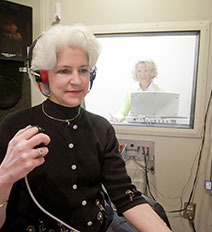You may experience a complete range of emotions when going in for your first hearing aid evaluation. When performing a hearing aid evaluation, our audiologist will take into account your medical history along with any symptoms you experience in your day-to-day life. Even if your hearing loss was from birth and not over time, there is still a lot of information to gain from these tests. In the event a hearing loss is detected we may recommend hearing aids as treatment.
Having your hearing tested
Once the audiologist has finished the background portion of the hearing evaluation, they will conduct a battery of tests. While hearing tests are incredibly detailed and can take some time to complete, they’re completely painless and will provide a wealth of information once the audiologist reviews the results. The results of your hearing evaluations will be plotted on an audiogram, which will enable the audiologist to measure the degree of your hearing loss and what pitches and frequencies it impacts. The most common treatment for hearing loss is hearing aids.
Selecting a hearing aid
Now that you have a diagnosis and recommended treatment, you’ll get to learn about the different hearing aid styles and features. Based on the results of your hearing evaluation, your audiologist will suggest a handful of hearing aids that will be most compatible with your hearing loss, lifestyle and technology wants. Narrowing down the list to a few devices is one of the major reasons the hearing aid evaluation is so important. Among these choices, it will be up to you to find the one you’re most comfortable with.
Deciding between hearing aid styles
These are the three types of hearing aid styles that you’ll want to consider during the hearing aid evaluation. Depending on the severity of your hearing loss, your aesthetic wants, technology needs and dexterity capabilities, there are three main styles to choose from: behind the ear (BTE), in the ear (ITE) and in the canal (ITC).
- BTE hearing aids are worn behind the ear, are slightly larger in size than the others, but are powerful and easier to handle when changing batteries.
- ITE hearing aids provide a little more discreetness than regular-sized BTEs, while still being powerful and accommodating for individuals with dexterity issues.
- ITC hearing aids are the most conspicuous because they’re worn partially or completely in the ear canal, however, they are much smaller, which means they can be difficult to insert and remove if you have any dexterity problems.
While each hearing aid style has an exhaustive list of pros and cons, it’s best to talk with your audiologist and evaluate the one that best fits your needs.
Let us help you find the right hearing aid
Going through a hearing aid evaluation is an important process when it comes to treating your hearing loss. With the help of our qualified audiologists, you’ll be able to select the perfect hearing aid for your lifestyle, privacy needs and technology wants. Let us help you find the right hearing device today!



